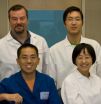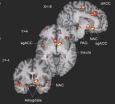(Press-News.org) JUPITER, FL, November 15, 2012 – For the past several years, Min Guo, an assistant professor at The Scripps Research Institute, has focused on the intricate actions of an ancient family of catalytic enzymes that play a key role in translation, the process of producing proteins.
These complex enzymes are a group of fundamental molecules that make building blocks for protein production. Present in every cell, these enzymes—known as aminoacyl-transfer RNA synthetases (tRNA synthetases)—select the proper amino acid and assign them to transfer RNAs to make a protein in the ribosome. As an essential step of determining the genetic code, tRNA synthetases have been around for billions of years.
However, this essential part of the protein-making machine did not stop evolving. Now, in a new study published online ahead of print on November 15, 2012, by the journal Molecular Cell, Guo, Ehud Razin of The Institute for Medical Research Israel-Canada, and a large team of international scientists have shown that this enzyme can actually also work in another fundamental process in humans. In this case, the enzyme activates a process that creates a copy of RNA from DNA—transcription, which is the first step leading to gene expression. All this takes is a single chemical alteration (phosphorylation) at a specific site on the enzyme, which then triggers a cascade of structure changes, freeing the enzyme from translation to another role regulating transcription.
"If you think about the structural changes that occur in the synthetase we looked at in the study, it's very much like the movie Transformers," Guo said. "It's a machine that changes structure and turns into another machine that can accomplish a completely different task—like from a car to a giant robot. This is the first time anyone has been able to show how you can change the function of this enzyme from a mechanistic perspective, to know exactly how that works."
This newly discovered ability has large implications for our understanding of immune response, including allergies, and cancer, Guo said.
He notes the unusual transformation of tRNA synthetases was initially discovered in mast cells, which are the body's first line of defense against pathogens such as bacteria and viruses. To recognize pathogens and other signs of infection, mast cells are dispersed throughout most tissues, but are crucially located at the body's interfaces with the environment, such as the skin and mucosae. Activation of mast cells is a key step in initiating allergies, in which activated mast cells secrete preformed mediators, such as histamine, and synthesize new mediators that augment the allergic response. It turns out that mast cells mobilize the tRNA synthetases to participate in transcriptional regulation and carry along this entire signal cascade, within minutes.
"This shows how a housekeeping machine can be re-shaped for a regulatory response," Guo said, "something that is only now starting to get noticed."
Recent research has also shown that the transformed synthetase in the new study also increases metastasis in breast cancer cells.
"By designing a way to prevent this synthetase transformation, you could potentially limit metastasis," Guo said. "But you have to know the mechanism before you can design something to alter it. This new study gives us a basic framework that shows how this transformation works."
The first authors of the study, "Structural Switch of Lysyl-tRNA Synthetase between Translation and Transcription," are Yifat Ofir-Birin of The Institute for Medical Research Israel-Canada and Pengfei Fang of TSRI. In addition to Guo, Razin, Ofir-Birin, and Fang, other authors include Steven P. Bennett, Jing Wang, Ryan Shapiro, Jorge Pozo, Paul Schimmel and Xiang-Lei Yang of TSRI (Sharpiro and Schimmel are also affilitated with the Skaggs Institute for Chemical Biology at TSRI); Inbal Rachmin, Jing Song, and Arie Dagan of The Institute for Medical Research Israel-Canada; Hui-Min Zhang and Alan G. Marshall of Florida State University; Sunghoon Kim of Seoul National University; and Hovav Nechushtan of the Hadassah Medical Center, Israel.
"This study required team work, as it spanned the boundaries of different biological fields, including cell biology, structural biology, immunity and cancer," Guo said. "This and future work is made possible by the close collaborations among scientists around the world."
INFORMATION:
The study was supported by the National Institutes of Health (grant numbers GM088278; GM23562; GM78359; and GM100136); National Science Foundation Division of Materials Research; the National Foundation for Cancer Research; the Global Frontier Project and the Ministry of Education, Science and Technology, Korea; the Israel Science Foundation; the United States Binational Science Foundation; the National Research Foundation of Singapore; the German-Israel Foundation for Scientific Research and Development; the Cooperation Program in Cancer Research of the Deutsches Krebsforschungszentrum; the Israel Ministry of Science and Technology; the State of Florida; and the U. S. Department of Energy.
Scientists show protein-making machinery can switch gears with a small structural change process, which may have implications for immunity and cancer therapy, compared to the movie The Transformers
2012-11-15
ELSE PRESS RELEASES FROM THIS DATE:
Genetics point to serious pregnancy complication
2012-11-15
New research at the University of Adelaide has revealed a genetic link in pregnant mums - and their male partners - to pre-eclampsia, a life-threatening complication during pregnancy.
Pre-eclampsia involves high blood pressure and fluid retention and can cause damage to the kidneys and liver. About 7% of pregnancies are affected by pre-eclampsia.
In a paper now online in the journal Placenta ahead of print publication, the researchers say they have found a genetic variant involving the AGT2R gene, which may predispose women to pre-eclampsia.
However, the genetic variant ...
VTT developes future energy solutions in cooperation with residents
2012-11-15
VTT is developing future energy solutions in cooperation with residents of the new research hotel in Otaniemi. The hotel offers rented furnished accommodation to visiting foreign research scientists, who will move in to the new building in November. The four-storey research hotel is located at Otaranta 4 and overlooks the sea. The hotel has 52 rooms ranging from 30 to 80 square metres, with common areas and facilities on each floor.
Residents' energy behaviour matters – up to a fourfold difference in consumption
Research Professor Miimu Airaksinen says that the role ...
Mercury poisoning ruled out as cause of Tycho Brahe's death
2012-11-15
In 2010, Tycho Brahe was exhumed from his grave in Prague, an event which received extensive international media coverage. Since then, a Danish-Czech team of researchers has been working to elucidate the cause of Tycho Brahe's death. The results of this intensive work now make it possible to rule out mercury poisoning as a cause of death.
For over four hundred years, Tycho Brahe's untimely death has been a mystery. He died on 24 October 1601 only eleven days after the onset of a sudden illness. Over the centuries, a variety of myths and theories about his death have arisen. ...
Study finds asthma is not linked to lower educational attainment
2012-11-15
Research led by Queen Mary, University of London has found that having asthma is not linked to poorer scores in national school examinations. In contrast, ethnicity and social deprivation were associated with poorer educational outcomes in the study, published in the journal PLOS ONE.
Long-term conditions in childhood – of which asthma is now the most common – may have a major impact on educational performance. However, in one of the world's first studies to link health, housing, benefits and educational data in over 12,000 children, researchers from Queen Mary, University ...
Structure of enzyme unravelled providing basis for more accurate design of chemotherapeutic drugs
2012-11-15
Cambridge, MA, November 15, 2012 – A group of researchers at the University of California, Berkeley have for the first time described the structure of the active site core of topoisomerase II alpha, an important target for anti-cancer drugs.
The type II topoisomerases are important enzymes that are involved in maintaining the structure of DNA and chromosome segregation during both replication and transcription of DNA. One of these enzymes, topoisomerase II alpha, is involved in the replication of DNA and cell proliferation, and is highly expressed in rapidly dividing ...
When the going gets tough, the tough get... more relief from a placebo?
2012-11-15
ANN ARBOR, Mich. — Are you good at coping when life gets tough? Do people call you a straight-shooter? Will you help others without expecting anything in return?
Those personality traits might do more than help you win a popularity contest. According to new University of Michigan-led neuroscience research, those qualities also might make you more likely to get pain relief from a placebo – a fake medicine.
And, the researchers show, it's not just your mind telling you the sham drug is working or not. Your brain's own natural painkiller chemicals may actually respond ...
Oxytocin keeps flirting folks at arm's length
2012-11-15
Flirting brings women and men closer. But the "social distance" ensures that they will keep a certain spatial distance from each other. Researchers under the leadership of the University of Bonn studied whether this distance can be diminished by the so-called love hormone, oxytocin. The exact opposite turned out to be true – men who were in a committed relationship even maintained a greater distance from an attractive woman when under the influence of oxytocin than their control group. The study has just been published in the renowned "Journal of Neuroscience."
When people ...
'It’s not like CSI': The science of the search for Richard III
2012-11-15
Search for King Richard III press portal: http://www2.le.ac.uk/offices/press/media-centre/richard-iii
DNA testing, environmental sampling and radiocarbon dating are some of the tests being undertaken to determine whether the skeleton found in Leicester was once Richard III - and there are also plans to do a facial reconstruction.
Lead archaeologist Richard Buckley, of the University of Leicester's Archaeological Services, has explained the schedule for the scientific processes the skeleton is being subjected to.
The complexity and rigorousness of the tests – along ...
RSV study shows potential for vaccine strategies to protect babies
2012-11-15
Research by the University of Warwick indicates that vaccinating families could protect young babies against a common winter virus which can be fatal for infants under six months.
Respiratory syncytial virus (RSV) typically leads to mild, cold-like symptoms in adults and older children but can be more serious and even fatal in infants under the age of six months as it can lead to bronchiolitis and pneumonia.
The virus is commonly found all over the world. In the UK, outbreaks generally start in November or December and last four to five months, peaking over the Christmas ...
Meteorites reveal warm water existed on Mars
2012-11-15
Image of the Lafayette meteorite available from pressoffice@le.ac.uk
New research by the University of Leicester and The Open University into evidence of water on Mars, sufficiently warm enough to support life, has been published this week in the journal Earth and Planetary Science Letters.
The study determined that water temperatures on the Red Planet ranged from 50°C to 150°C. Microbes on Earth can live in similar waters, for example in the volcanic thermal springs at Yellowstone Park, the scientists behind the research point out.
The research is based on detailed ...


